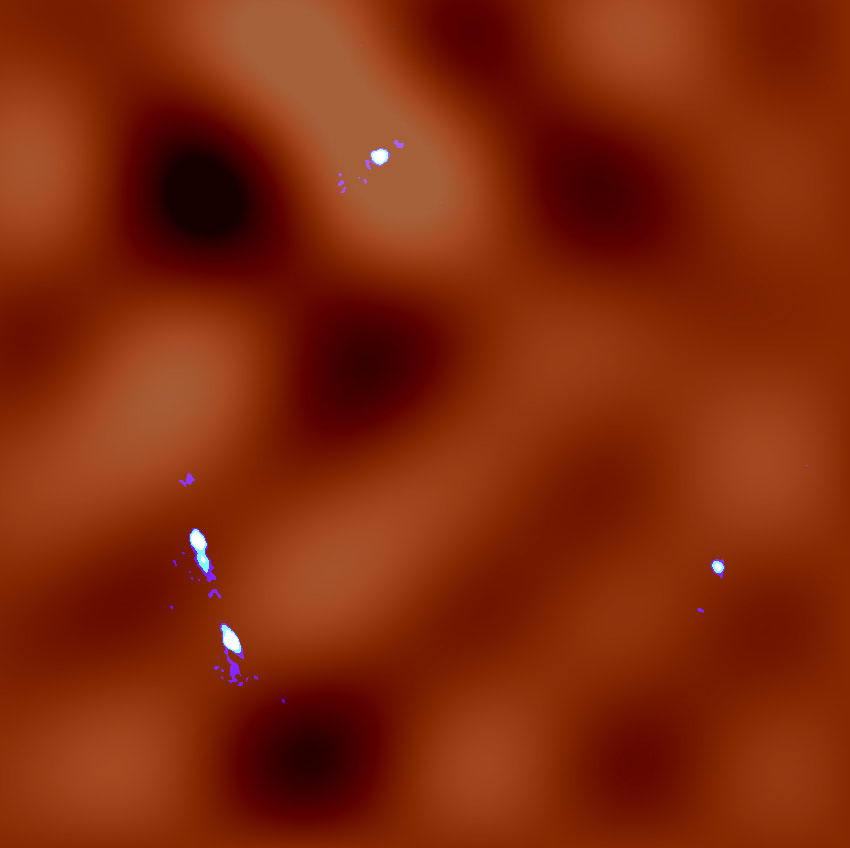Dark matter remains mysterious and… well… dark. While we don’t yet have a definite idea of what this cosmic “stuff” is made of, astronomers are learning more about its distribution throughout the Universe. Since we can’t see it directly, observers need to use indirect methods to detect it. One way is through gravitational lensing. Another is by looking for emissions from hydrogen gas associated with small-scale dark matter structures in the Universe.
A group of astronomers led by Kaiki Taro Inoue of Kindai University in Japan used the Atacama Large Millimeter Array in Chile to study a distant gravitational lens system called MG J0414+534. A massive foreground galaxy is bending and distorting the light from a distant quasar that lies some 11 billion light-years away. The result is four images of the quasar. When they looked at the data, the team found some strange anomalies in the images. They are actually variations in the distribution of dark matter along the line of sight between us and the quasar. The gravitational lens magnified the fluctuations and analysis of the data allowed them to map the fluctuations down to a scale of 30,000 light-years.

What The Blobs of Dark Matter Mean
Throughout the universe, dark matter is associated with massive galaxies and galaxy clusters. However, small-scale clumps and distributions aren’t as well understood. So, astronomers want to find ways to map the smaller concentrations of it. Gravitational lensing provides one way to do that. In the case of MG J0414+0534, the positions and shapes of the lensed quasar images look a little strange. They don’t fit the model of gravitational lensing predicted when you plug in the numbers for the galaxy and its associated dark matter component.
The fluctuations indicate that there’s a gravitational lensing effect from the smaller concentrations, in addition to that of the galaxy and its dark matter shell. In this case, there are spatial fluctuations in the density of dark matter down to a size of about 30,000 light-years. That’s way smaller than what the scientists term the “cosmological scale” for larger concentrations (several tens of billions of light-years).
Interestingly, the team’s work shows that such smaller concentrations work with predictions made about cold dark matter (CDM). Essentially, it says that dark matter clumps exist within galaxies, but also can populate intergalactic space. The gravitational lensing effects due to the clumps of dark matter found in this study are so small that it is extremely difficult to detect them alone. That’s why the team used ALMA to detect the fluctuations. It can provide very high-resolution radio observations of fluctuations caused by the smaller concentrations of dark matter.
A Starless Dark Matter Halo in the Local Universe?
Astronomers used a giant radio telescope, the Five-Hundred-Aperture Spherical Radio Telescope (FAST) in China to look at another interesting dark matter-related object that lies near the galaxy M94. The system, which they call “Cloud-9, is a source of 21-centimeter radio emissions from cold neutral interstellar hydrogen. Interestingly, Cloud-9 appears to be relatively starless. So, astronomers using FAST wondered if this 21-cm emission from the cloud could function as a tracer of dark matter. In a preprint paper, they describe Cloud-9 as being very similar to something called a REionization-limited HI Cloud (RELHIC). Essentially, a RELHIC is a starless dark matter halo. It’s filled with gas in equilibrium with the cosmic ultraviolet background. (That’s the “wash” of UV radiation produced by stars and galaxies.)

It turns out that in the most popular model of cold dark matter, galaxies form in the centers of halos of a certain size. The models also show that there should be a number of collapsed dark matter halos. And, there’s no reason why there shouldn’t be smaller “blobs” throughout the Universe. Interestingly, many low-mass versions of dark matter halos remain dark or starless even after billions of years of cosmic evolution. So, essentially, not every such halo contains a galaxy. The RELHICs are halos that have no stars (or at least none that have been detected so far).
Observing Cloud-9
A team led by astronomer Alejandro Benitez-Llambray of the Universita degli Studi di Milano Bococca in Italy reports that Cloud-9 is an extended HI cloud. They measured the column densities of gas there. Its characteristics point to it being associated with a dark matter halo. If it is a cold dark matter RELHIC and it lies at (or near) the distance of M94 (around 18 million light-years), that makes it one of the closest RELHICs known.
Cloud-9 will require a lot more study, and the authors of the current work suggest that higher-resolution observations are needed. For one thing, its distance really needs to be pinned down. So, future observations using the MeerKAT telescope, the Very Large Array, or even the FAST in China could be made. Follow-up observations using the Hubble Space Telescope could help astronomers find out whether or not Cloud-9 definitely has any stellar components.
The authors do suggest that this mysterious cloud could have a galaxy at its heart, but that it’s too faint to be detected. Certainly in the early Universe, galaxies and stars formed as a result of gravitational growth of density fluctuations in dark matter. Hydrogen and helium (the building blocks of stars) were attracted by the clumps of dark matter and began to form stars. However, that applies to the distribution of dark matter at the galaxy and larger scales. Accumulations of dark matter on smaller scales, such as with Cloud-9, really aren’t well understood. That’s why further observations of Cloud-9 will definitely help determine the full extent of its dark matter content. They could also shed some light on how galaxies form at the small scale of smaller dark matter accumulations.
For More Information
New Cosmological Constraints on the Nature of Dark Matter
ALMA Measurement of 10 kpc Scale Lensing-power Spectra toward the Lensed Quasar MG J0414+0534
Is a Recently Discovered HI Cloud Near M94 a Starless Dark Matter Halo?

